
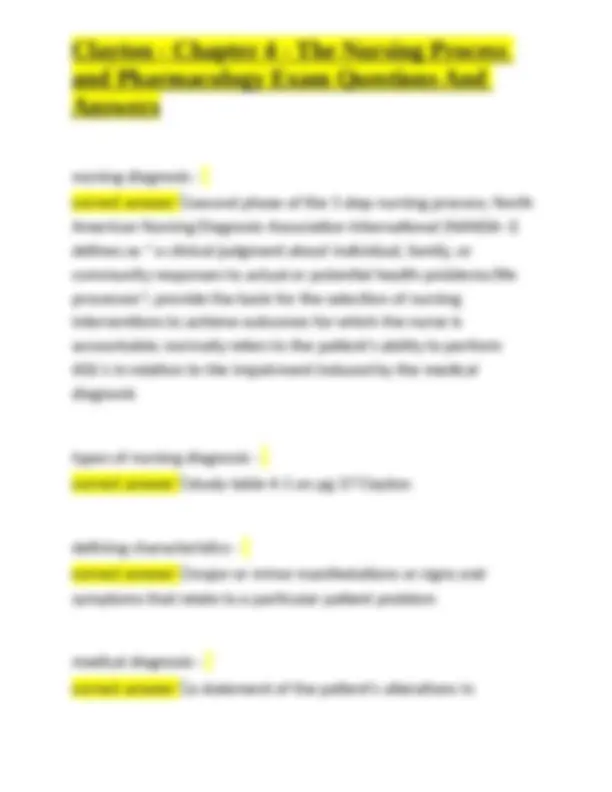
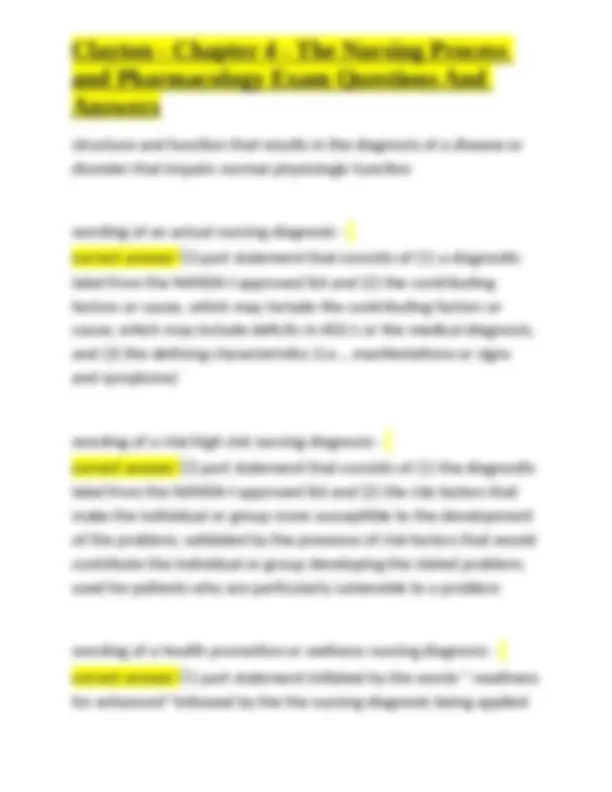
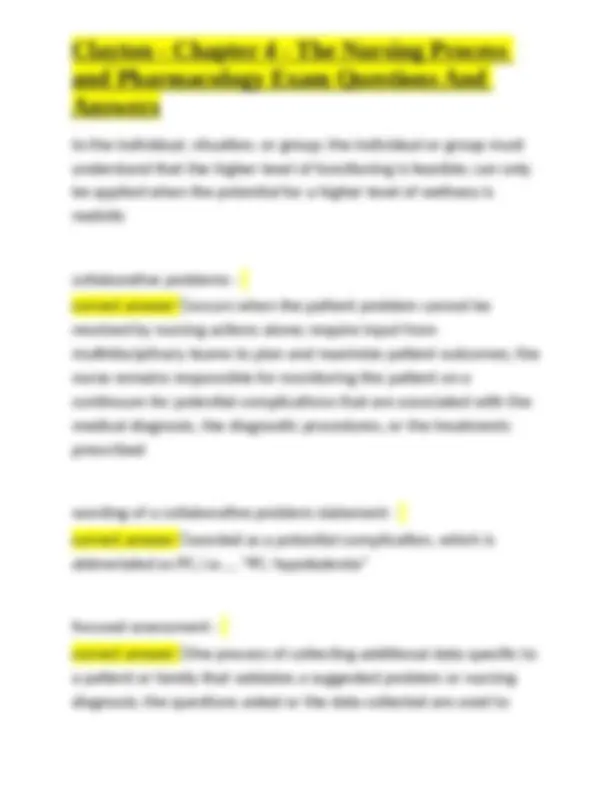
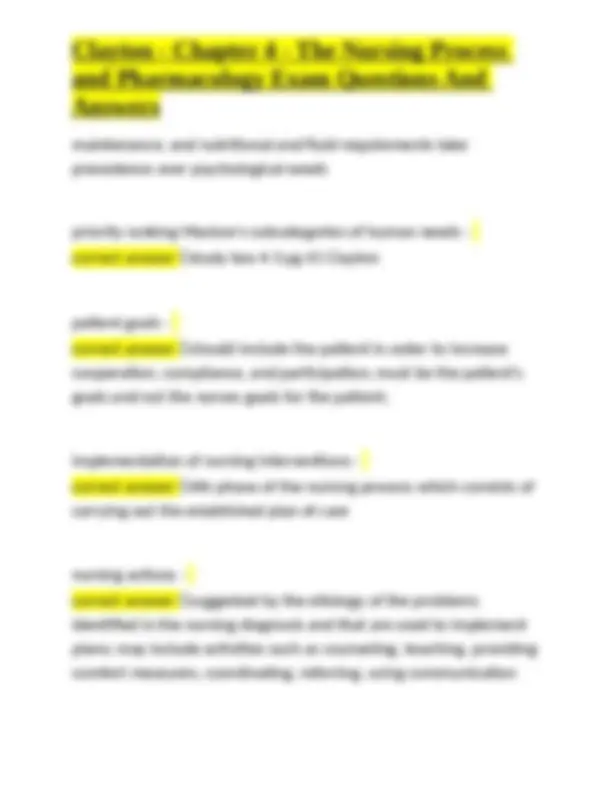
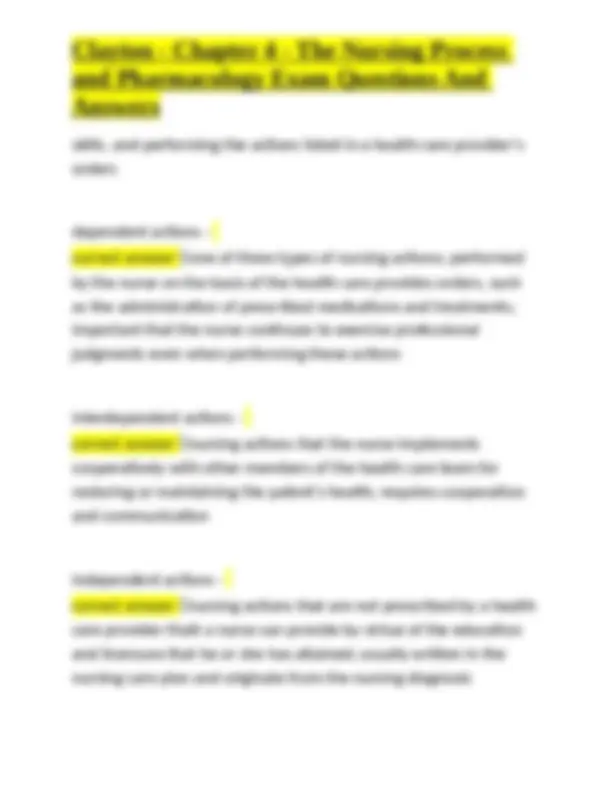
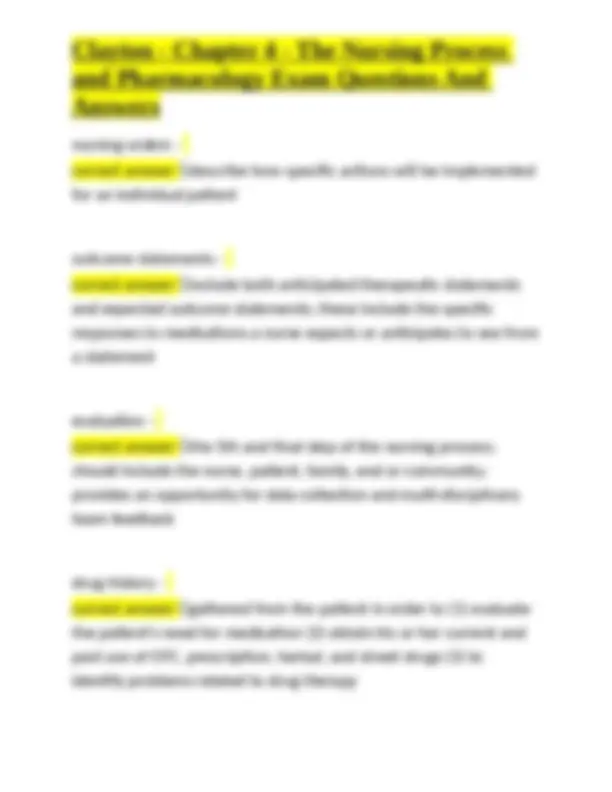



Study with the several resources on Docsity

Earn points by helping other students or get them with a premium plan


Prepare for your exams
Study with the several resources on Docsity

Earn points to download
Earn points by helping other students or get them with a premium plan
Community
Ask the community for help and clear up your study doubts
Discover the best universities in your country according to Docsity users
Free resources
Download our free guides on studying techniques, anxiety management strategies, and thesis advice from Docsity tutors
Clayton - Chapter 4 - The Nursing Process and Pharmacology Exam Questions And Answers
Typology: Exams
1 / 13

This page cannot be seen from the preview
Don't miss anything!








nursing process - correct answer ✅foundation for the clinical practice of nursing; provides the framework for consistent nursing actions and involves the use of a problem solving approach rather than intuitive approach; also provides a method for evaluating outcomes; consists of an assessment, a nursing diagnosis or collaborative problem, planning, implementation, and evaluation nursing classification systems - correct answer ✅i.e... Nursing Minimum Data Set (NMDS), Nursing Interventions Classifications (NIC), Nursing Outcomes Classification (NOC) are information systems that are designed to provide a standardized language for reporting and analyzing nursing care delivery that has been individualized for the patient multidisciplinary team - correct answer ✅members provide and promote valuable clinical expertise, a holistic approach, and collaboration for the health care of individual patients principles of the nursing process and their application to pharmacological needs -
correct answer ✅study box 4-1 pg 35 Clayton as well as fig 4-1 pg 36 Clayton assessment - correct answer ✅first phase of the 5 step nursing process; a continuous process that begins upon admission and continues until discharge; comprised of collecting a full nursing history and medical history, professional observations, physical examinations, and interpreting diagnostic test results commonly used assessments - correct answer ✅head to toe assessment; body systems assessment; and Gordon's Functional Health Patterns head to toe assessment - correct answer ✅nursing assessment that focus's on patient's physiology Gordon's Functional Health Patterns Model - correct answer ✅includes sociocultural, psychological, spiritual, and developmental factors that affect the individual's needs
structure and function that results in the diagnosis of a disease or disorder that impairs normal physiologic function wording of an actual nursing diagnosis - correct answer ✅3 part statement that consists of (1) a diagnostic label from the NANDA-I approved list and (2) the contributing factors or cause, which may include the contributing factors or cause, which may include deficits in ADL's or the medical diagnosis, and (3) the defining characteristics (i.e....manifestations or signs and symptoms) wording of a risk/high risk nursing diagnosis - correct answer ✅2 part statement that consists of (1) the diagnostic label from the NANDA-I approved list and (2) the risk factors that make the individual or group more susceptible to the development of the problem; validated by the presence of risk factors that would contribute the individual or group developing the stated problem; used for patients who are particularly vulnerable to a problem wording of a health promotion or wellness nursing diagnosis - correct answer ✅1 part statement initiated by the words " readiness for enhanced" followed by the the nursing diagnosis being applied
to the individual, situation, or group; the individual or group must understand that the higher level of functioning is feasible; can only be applied when the potential for a higher level of wellness is realistic collaborative problems - correct answer ✅occurs when the patient problem cannot be resolved by nursing actions alone; require input from multidisciplinary teams to plan and maximize patient outcomes; the nurse remains responsible for monitoring the patient on a continuum for potential complications that are associated with the medical diagnosis, the diagnostic procedures, or the treatments prescribed wording of a collaborative problem statement - correct answer ✅worded as a potential complication, which is abbreviated as PC; i.e..., "PC: hypokalemia" focused assessment - correct answer ✅the process of collecting additional data specific to a patient or family that validates a suggested problem or nursing diagnosis; the questions asked or the data collected are used to
plan that sequences detailed clinical intervention to be performed over a projected amount of time for a specific case type or disease process caremap - correct answer ✅one type of critical care pathway that is used to document patient progress towards established outcomes that are required for discharge evidenced based practice - correct answer ✅aka EBP; "the incorporation of evidenced from research, clinical expertise, and patient preferences into decisions about the health care of individual patients; the goals is to improve patient outcomes by implementing best practices, which have evolved from scientific studies priority setting - correct answer ✅occurs after the nursing diagnosis and collaborative problems have been identified; often Maslow's hierarchy of needs is used as a model to organize the patient's needs in relation to their direct effects on the maintenance of homeostasis; i.e... physical needs such as oxygenation, temperature
maintenance, and nutritional and fluid requirements take precedence over psychological needs priority ranking Maslow's subcategories of human needs - correct answer ✅study box 4-3 pg 41 Clayton patient goals - correct answer ✅should include the patient in order to increase cooperation, compliance, and participation; must be the patient's goals and not the nurses goals for the patient; implementation of nursing interventions - correct answer ✅4th phase of the nursing process which consists of carrying out the established plan of care nursing actions - correct answer ✅suggested by the etiology of the problems identified in the nursing diagnosis and that are used to implement plans; may include activities such as counseling, teaching, providing comfort measures, coordinating, referring, using communication
nursing orders - correct answer ✅describe how specific actions will be implemented for an individual patient outcome statements - correct answer ✅include both anticipated therapeutic statements and expected outcome statements; these include the specific responses to medications a nurse expects or anticipates to see from a statement evaluation - correct answer ✅the 5th and final step of the nursing process; should include the nurse, patient, family, and or community; provides an opportunity for data collection and multi-disciplinary team feedback drug history - correct answer ✅gathered from the patient in order to (1) evaluate the patient's need for medication (2) obtain his or her current and past use of OTC, prescription, herbal, and street drugs (3) to identify problems related to drug therapy
primary source - correct answer ✅the patient, when reliable; the first major source of information for determining the patient's drug history subjective data - correct answer ✅along with objective data, form the baseline for formulating a drug related nursing diagnosis; subjective pieces of information provided by the patient about the effects of medicine objective data - correct answer ✅along with subjective data, form the baseline for formulating a drug related nursing diagnosis; objective pieces of information gathered from the use of physiologic parameters and nursing observations and assessments secondary sources - correct answer ✅relatives, significant others, medical records, lab reports, nursing notes, other health care professionals; subject to interpretations, should be analyzed with the use of other portions of the database to validate the conclusions that are reached
therapeutic intent - correct answer ✅answers the questions "why was a drug prescribed" and "what symptoms are intended to be relieved"; used in addition to common adverse effect and serious adverse effects to plan for nursing care common adverse effects - correct answer ✅less serious effects of a drug; also used in the planning process; may be alleviated with appropriate nursing care serious adverse effects - correct answer ✅more serious effects of a drug; also used in the planning process; often can still be alleviated with appropriate nursing care